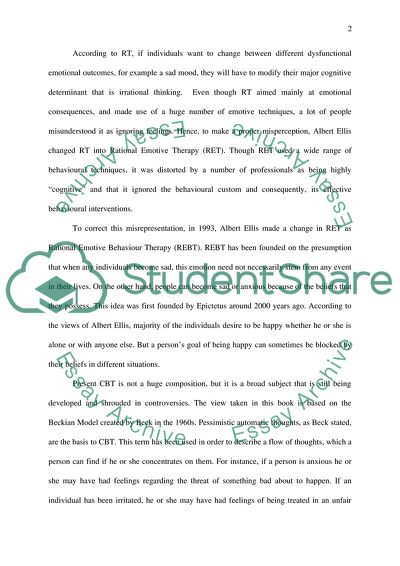Cite this document
(Cognitive Behavioural Therapy and Rational Emotive Behavioural Therapy Coursework Example | Topics and Well Written Essays - 2250 words, n.d.)
Cognitive Behavioural Therapy and Rational Emotive Behavioural Therapy Coursework Example | Topics and Well Written Essays - 2250 words. https://studentshare.org/psychology/1792675-compare-and-contrast-aspects-of-cognitive-behaviour-therapy-bbt-and-rebt-with-the-core-theoretical-model-person-centred
Cognitive Behavioural Therapy and Rational Emotive Behavioural Therapy Coursework Example | Topics and Well Written Essays - 2250 words. https://studentshare.org/psychology/1792675-compare-and-contrast-aspects-of-cognitive-behaviour-therapy-bbt-and-rebt-with-the-core-theoretical-model-person-centred
(Cognitive Behavioural Therapy and Rational Emotive Behavioural Therapy Coursework Example | Topics and Well Written Essays - 2250 Words)
Cognitive Behavioural Therapy and Rational Emotive Behavioural Therapy Coursework Example | Topics and Well Written Essays - 2250 Words. https://studentshare.org/psychology/1792675-compare-and-contrast-aspects-of-cognitive-behaviour-therapy-bbt-and-rebt-with-the-core-theoretical-model-person-centred.
Cognitive Behavioural Therapy and Rational Emotive Behavioural Therapy Coursework Example | Topics and Well Written Essays - 2250 Words. https://studentshare.org/psychology/1792675-compare-and-contrast-aspects-of-cognitive-behaviour-therapy-bbt-and-rebt-with-the-core-theoretical-model-person-centred.
“Cognitive Behavioural Therapy and Rational Emotive Behavioural Therapy Coursework Example | Topics and Well Written Essays - 2250 Words”. https://studentshare.org/psychology/1792675-compare-and-contrast-aspects-of-cognitive-behaviour-therapy-bbt-and-rebt-with-the-core-theoretical-model-person-centred.


